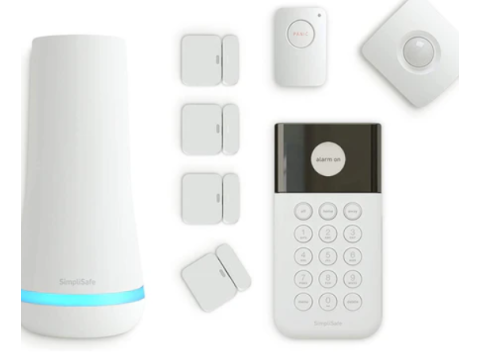Introduction
A GSM alarm system typically includes a control panel plus various sensors to detect threats such as motion, door openings, glass breakage, or smoke. While many of these sensors resemble those found in standard (non-GSM) alarm setups, the key difference is that all alerts route through cellular connectivity, allowing rapid notifications via text message or phone call. Below, we’ll discuss the two primary sensor types—wired and wireless—as well as important considerations for each, such as battery usage, radio frequency protocols, and installation complexity.
Wireless Sensors for GSM Alarms
Wireless sensors connect to the GSM control panel via radio waves, eliminating the need for extensive cable installations. This approach often simplifies installation, especially in homes or buildings where running wires is impractical or aesthetically undesirable.
Key Features of Wireless Sensors
Signal Encryption
- Fixed Code: Common in inexpensive or generic sensors (frequently from certain Asian manufacturers). Vulnerable to “code grabbing” techniques, requiring only simple radio-recording gear.
- Rolling Code (Keeloq): A dynamic encryption method that changes the code with each transmission. This makes it much harder for an attacker to intercept or spoof sensor signals.
Battery Life & Power Efficiency
- Most wireless sensors are battery-powered. Their battery life typically ranges from 6 to 12 months under normal conditions, but budget models may drain faster due to less efficient radio components.
- Power-Saving Algorithm: For instance, a wireless motion detector may temporarily block re-transmissions after it sends an alert, preventing continuous “trips” from draining the battery if someone stays in the area.
Functionality & Microprocessor Control
- Basic Models: Often just have a simple encoder converting the sensor’s analog signals into digital radio output.
- Advanced Units: Feature microprocessors for tasks like signal encryption, battery-level monitoring, self-diagnostics, and power-saving modes. When battery power drops below ~80%, they can send a low-battery alert to the control panel.
Transmission Range
- Specs might read “100–150 meters (open field).” Indoors, range is reduced by walls and reinforced concrete.
- Some models include an extendable antenna to boost range to 300–500 meters, but higher transmission power can deplete batteries faster.
Installation Tip: Always verify that the chosen wireless sensors share the same frequency and communication protocol as your GSM panel or receiver unit. Mixed-brand setups might be incompatible unless specifically designed to work together.
Wired Sensors for GSM Alarms
Unlike their wireless counterparts, wired sensors transmit signals via dedicated cables to the GSM control panel or to an input module. They are often used in larger or more permanent installations.
Advantages of Wired Sensors
- No Battery Replacement
- Wired sensors draw power from the central panel, eliminating battery-related downtime or maintenance.
- More Robust Signal
- Hardwired connections are not susceptible to radio interference or signal jamming.
- Immediate Tamper Alerts
- If an intruder cuts a cable, the alarm panel can detect an open circuit immediately and sound an alert.
Drawbacks
- Complex Installation: Running cables through walls, ceilings, or conduits can be labor-intensive and expensive. This may be prohibitive in historic buildings or newly renovated homes.
- Aesthetics: Wires can compromise interior design unless carefully concealed.
Placement and Selection of GSM Alarm Sensors
To maximize security, plan the exact types and positions of sensors according to the property’s layout and vulnerability points:
Glass-Break Sensors
- Ideal for windows, glass doors, and storefronts.
- Typically installed on stationary building structures (walls, ceilings) facing the glass to detect shattering sounds or impacts.
Vibration Sensors
- Mount on walls or other structural elements that intruders might breach by drilling or cutting.
- Adjust sensitivity to account for environmental vibrations (e.g., heavy traffic outside).
Motion Detectors
- Useful both indoors and at building entrances.
- Avoid placing near HVAC vents, heaters, or bright lights to minimize false alarms.
Door & Window Contacts
- Monitor whether doors or windows are opened.
- Typically installed at major access points such as front entrances, back doors, balconies, or emergency exits.
Smoke/Heat/Flame Detectors
- Attach to ceilings or walls in every major room.
- For high-risk areas (like a furnace room or garage), consider heat or flame detectors.
Water/Gas Leak Detectors
- Install near piping, water heaters, or gas appliances.
- Warn of leaks before they cause serious damage or hazards.
When to Choose Wireless vs. Wired
Wireless
- Ideal for:
- Smaller sites like apartments, condos, private houses, or remote cabins.
- Buildings where running new cables is difficult or impossible (historic properties, post-renovation areas).
- Advantages:
- Easiest to install (no drilling walls to run cables).
- Minimal impact on décor or property structure.
- Considerations:
- Ongoing battery maintenance.
- Potential radio interference in dense urban environments.
- Must ensure robust encryption to prevent hacking or signal replay.
Wired
- Ideal for:
- Larger commercial or industrial sites where cable infrastructure is planned from the outset.
- Locations with high levels of electromagnetic interference (factories, steel-reinforced buildings).
- Advantages:
- Unlimited power from the alarm panel (no battery swaps).
- Less vulnerability to signal jamming.
- Considerations:
- Higher upfront labor costs for running cables.
- May require retrofitting or specialized conduits.
Final Thoughts
Both wired and wireless sensors can effectively enhance your GSM alarm system—what matters is choosing the right technology for your property’s size, construction, and security needs:
- Wireless is generally recommended for smaller residences or recently renovated spaces where cabling is impractical.
- Wired suits larger buildings or areas prone to EMI and where you can incorporate cable runs into the construction process.
Either way, properly placing and calibrating your sensors is key to reliable performance. For help selecting the best sensors—whether motion, door/window contacts, glass-break detectors, or specialized leak sensors—visit safsale.com. Our experts can guide you through every step, from initial planning to final installation, ensuring your GSM alarm system safeguards what matters most.

